What’s In This Guide
This buyer’s guide is for first-time drone racers who want to educate themselves on:
- what FPV/drone racing is all about
- the most important factors & features to consider when buying a racing rc drone; and,
- the best racing drones to buy.
NOTE: some links on this page point to Amazon.com, and I may earn a commission when you purchase those products.
What Is A Racing Drone?

A racing drone is a small quadcopter unmanned aerial vehicle (UAV) that is purpose-built to compete in FPV (first person view) racing events held in most major cities around the world. See the list of drone events below, for more details on these.
NOTE: Racing drones are not the same as camera drones like the Phantom 4 Pro. Camera drones like the Phantom fly “slow and low” and are designed to capture high-quality video of surfing contests, real estate and landscapes. A racing quadcopter’s camera can’t do that.
To learn more about camera drones check out our camera drone buyer’s guide.
What’s Not Covered Here
This racing drone guide does not cover advanced modding; the intricacies of optimizing components; nor, detailed DIY assembly instructions.
We also don’t discuss technical performance parameters, like the correct prop blade angle of attack.
For technical and DIY deep-dives, check out the following excellent websites and blogs:
- RCGroups MultiRotors Forum
- Reddit/r/Multicopter
- Down-And-Dirty-Drones’ Drone Physics Guide
- TauLabs Flight Software Forum
- MiniQuad Test Bench – motors and ESC performance testing
- DroneTrest – detailed component buying guides
- RotorBuilds.com – dozens of custom builds, crowd-ranked and tested. I love the Purple Haze.
- UAVFutures video reviews – entertaining video DIY guides and reviews of the latest FPV / racing drones
Read Our Reviews
After reading this guide, you can learn more about some of the leading racing drones for sale today by reading our reviews.
Happy flying 🙂
Best FPV Racing Drones (Ready-To-Fly)
Top 3 RTF Racing Drones For Sale
The following three picks are Ready To Fly (RTF). Little to no assembly required – you can fly them right out of the box.
Blade Inductrix FPV

BEGINNER
A nearly unbreakable Tiny Whoop FPV drone that is perfect for first-time racers.
Eachine Wizard X220

INTERMEDIATE
An affordable and durable ready-to-fly FPV drone, suitable for 250-class events.
Vortex 250 PRO

EXPERT
Lightweight, durable and super-fast 250 class winner for experienced quad pilots. Easy repairs, too.
Other Great Ready-to-Fly FPV Racing Drones
NOTE: many of the links below point to Amazon.com, and I may earn a commission if you buy after clicking them.
- Hubsan H107D FPV X4 – a great starter drone that’s starting to show its age. Less than $100.
- BFight 210 $150 to $175
- Furibee Fuuton 200 less than $200
- Diatone Tyrant S about $200
- Hubsan X4 Brushless FPV Quad Less than $300
- Team BlackSheep TBS Vendetta Less than $1,000
Winning Drones are Built, not Bought.
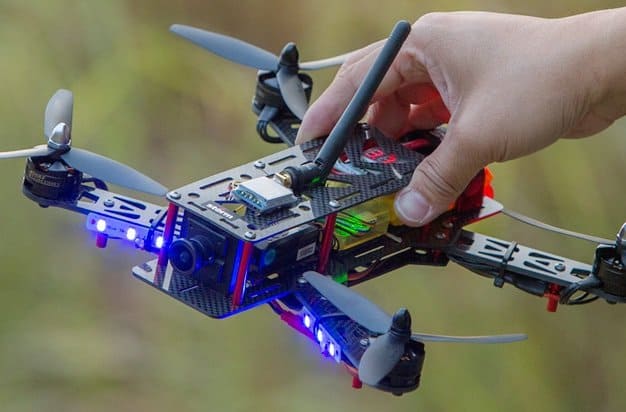
If you take a close look at drone race results, you’ll notice that pretty much every winning drone was custom-built by its owner.
That’s because drone racers modify their aircraft – a lot.
Just like in other forms of competitive flying, drone racers are constantly looking for new gear and tweaks that will give them an edge. Modding is common in drone racing because drone technology is advancing very quickly.
If you want to WIN at drone racing, the best advice I can offer you is:
- pick your racing class and league first *see list below
- select your aircraft kit, flight controller, RC controller and FPV gear very carefully (use this guide)
- keep modding your aircraft, until you win (learn from others online and at events)
This guide will help you do that.
First Time Racer? Ignore What I Just Said
If you are new to drone flying or racing, then you definitely should start out using an inexpensive ready-to-fly (RTF) mini drone.
Buying an starter FPV drone is important, because you’ll want to learn how to race and get comfortable flying through a camera view, without losing a bunch of time and money.
And believe me: you WILL crash your drone, many times. You WILL make mistakes.
Better you learn on a less expensive platform – right?
A Tiny Whoop class micro quad FPV drone is the top choice among budding drone racers, today.
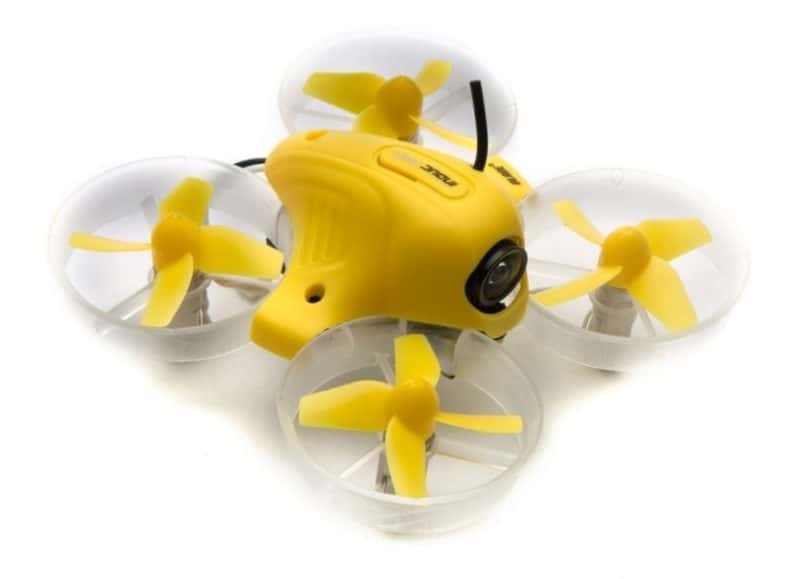
For example, the Blade Inductrix FPV is inexpensive, light and almost unbreakable. It comes with an integrated fixed mount camera and an RC Transmitter with a controller-mounted FPV monitor. It has everything you need to learn how to race using FPV video.
Here’s what it feels like to fly one of these around your house (FPV headset is extra):
LEARN MORE ABOUT THE BLADE INDUCTRIX FPV
After you’ve mastered flying a micro drone inside, you’ll be ready to move up to assemble-and-mod racers like the Vortex 250 PRO – and start WINNING.
Why People Race Drones
Because it’s fun! This kind of fun:
Video courtesy Mashable
Cool, huh?
Racing Leagues & Meetups
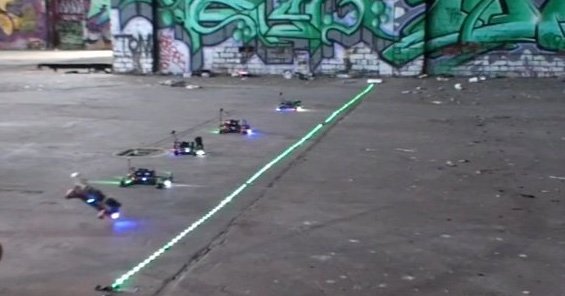
The first thing you need to decide when buying a racing drone is whether you will compete in a racing league or in less formal events and meetups.
The racing format will dictate the type of aircraft, controller, FPV gear and budget you’ll need to compete and enjoy racing.
Drone Racing Leagues
Drone racing leagues are popping up all over the world right now.
Each league has different rules that dictate the type of equipment (standard spec or open spec), the race environment, rules for combat and overtaking, etc. etc.
Here are the racing leagues I know about, so far:
- Aerial Grand Prix: A gates-and-flags racing league for 250Mini, Pro Super Mini and Open Class rigs. Events in major cities world wide. Indoor and outdoor tracks.
- Aerial Action Sports League: a 3-hour stunt drone and combat drone event.
- FPVRacing.TV: a social network of racers organized into teams. Open-spec. Lists global events.
- MultiGP: for first-person view (FPV) radio-controlled quadcopters only. Started in 2015, currently adding US city chapters.
- RacingFPV.com: Canadian indoor racing league; 250mm and open class. Flags and gates.
- DroneDerby
- Drone Nationals
- The Mini Quad Club: popular Facebook group where meetups and mods are actively discussed
Make sure you record the minimum and maximum specs for suitable aircraft in the league you like best. Many leagues today use 250 mm / 5-inch mini quads.
For a map of upcoming racing events, check out this map maintained by the reddit.com/r/Multicopter/ community.
Local Meetups
In addition to drone racing leagues, there are plenty of local User Groups, FPV Meetups and similar events happening in most US and European cities today.
Most local events are open-spec, meaning they’ll accept any and all types of aircraft and controllers.
The main purpose of a meetup is to have fun and to learn from each other.
Socializing is also a goal, but it can be difficult while everyone is wearing a pair of FPV goggles.
You can find local drone racing meetups and user groups on Meetups.com and Reddit.
I prefer local meetups, because I’m free to do whatever I want with my aircraft. And, I tend to learn more about mod options from racers who are constantly modding their drone. But that’s just me.
Indoor vs Outdoor

Most drone racing league events take place inside where weather is not a factor. This is to ensure that no drone has an unfair advantage due to the environment on that particular day. The idea of league racing is to pit machine and team vs. machine and team, competing purely on piloting skill and equipment design.
On the other hand, local meetups and user groups race wherever they can find a suitable course. Indoor and outdoor meetups exist in most cities.
Rotorcross
Two or more racers compete at the same time to see who crosses the finish line first. Crashes happen. Most exciting format!
Drag Race
A race between two or more drone racers at the same time, to see which one accelerates over a short distance the fastest. Distance is 100 yards or 100 meters, usually.
Time-Trial
Each drone runs the course alone. Shortest elapsed time wins.
What’s In a FPV Racing Quad?
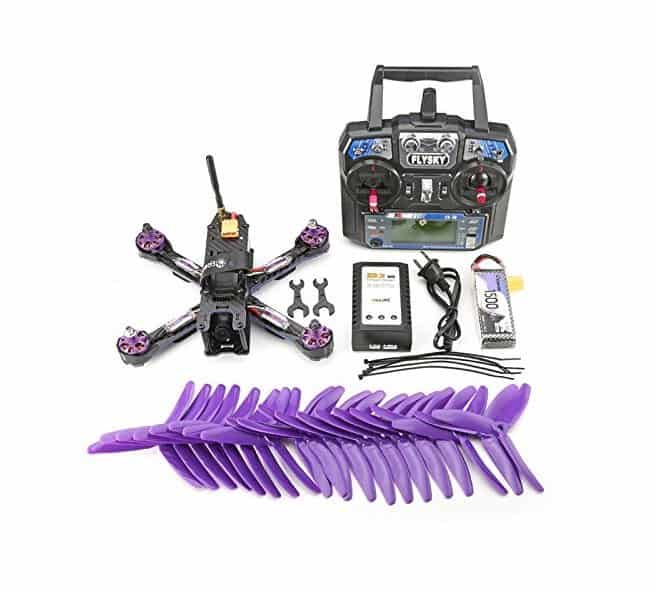
A typical FPV racing quadcopter – whether assemble-to-fly or ready to fly – includes the following components:
- Air Frame
- 4 motors + spares
- 4 ESCs + spares
- 4 props + lots of spares
- RC Flight controller
- Lithium-polymer (LiPo) battery + spares
- FPV Video transmitter (vTx) and receiver (vRx)
- Radio Control transmitter (Tx) and receiver (Rx)
- Antennas
- Battery straps
- FPV goggles
- Board camera for FPV feed
- HD camera for recording (optional, adds weight)
A ready-to-fly (RTF) racing drone like the Blade Inductrix FPV and the Vortex 250 Pro will come with everything you need, integrated and bug-free. You may need to buy extra props and batteries, though.
If you choose to assemble your own (ARF), then make sure you get everything listed above – with plenty of spare props and a couple of extra batteries.
Budget
You can get into drone racing for as little as $200, but WINNING races will cost more.
If you’re not into assembling your own drone, then you can purchase a ready-to-fly racing drone like the Blade Inductrix for as little as $200. The Inductrix is a fast, inexpensive micro quad that includes an onboard camera, reliable RC controller with live feed video display and excellent controller software. You probably won’t win many events with it, but it will teach you the ins and outs of racing without risking a lot of time and cash.
To compete in local meetups, a budget of $300-700 will get you a 250mm spec racing drone with a good RC controller, flight controller, FPV video feed and a small video display. The Vortex 250 Pro and Eachine Wizard X220 are two popular choices for first-time competitors.
Add another $300-500 for a pair of high-quality first-person-view (FPV) goggles like the Fat Shark Dominator V3.
Budgeting for a racing league? you should budget at least $1,000 to build a competitive racer for any league.
Ready-to-Fly (RTF) Racing Drones
The following manufacturers and retailers sell ready-to-fly (RTF) racing drones.
Ready-to-fly quads are exactly what they sound like: you buy one, open the box, charge the batteries and start flying. Most of the kinks have been worked out.
Here are some of the more popular RTF Racing Drones sold over the past few years:
- Blade Inductrix FPV (on Amazon): cheap and popular starter mini-drone; complete w/ 720p FPV camera, controller and excellent software. Tiny and tough.
- Eachine Wizard X220 FPV (on Amazon): popular, fast (68 mph) and affordable, this Tiny Whoop class FPV drone is durable, a lot of fun and a great value. Lots of upgrades are available.
- Walkera 210 FPV (on Amazon): a popular entry-level RTF racing drone sold on Amazon.
- Diatone Crusader GT2 200: one of the fastest RTF racers you can buy. Not cheap!
- Vortex 250 PRO: this racer by ImmersionRC is capable of winning 250 class events. It’s also tough as nails and repairs are easy/cheap to make.
Caution: lots of RTF racing quadcopters on the market today are actually assembled from kits and components by the retailer. This doesn’t mean they bad, just that you’re depending on the retailer staff to know what they’re doing.
Check out this awesome video of a QAV250 and Storm Type A racing in a heavily wooded park:
How To Build Your Own FPV Racing Drone
I was going to write a long-winded guide on this.
But honestly, the following 30-minute tutorial by Charpu, one of the best racing drone pilots around, explains the process better than I ever could. It’s a couple of years old, but Charpu knows a crapload more than I do about this.
Here are the components Charpu used to build-out this particular flyer (Note: this video is about 3 yrs old):
NOTE: the following links point to Amazon.com, and I may earn a commission if you buy within the next 24 hours.
-
- Frame QAV250 Mini FPV
- Motors Lumenier FXC1806 (2300kv)
-
- Electronic Speed Controllers (ESC) Lumenier 12A
- Propellers Gemfan 5×3
- Battery Lumenier 1300mAh Lipo
- Flight Controller Acro Naze32
- FPV Goggles Fat Shark Teleporter V3
- Radio Transmitter & Receiver FrSky Taranis X9D 2.4GHz
NOTE: most of these components are outdated now! (don’t build the drone above)
In short, it’s not that hard to build your own FPV racing drone.
Tweaking it to win is where the risk / reward starts to get tricky.
Assemble-to-Fly (ARF) Components
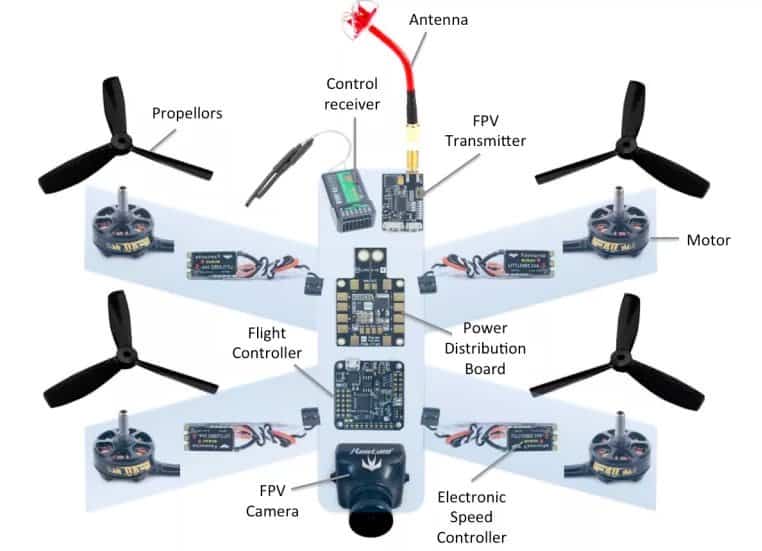
I don’t have enough experience to list every possible quality component in the racing drone world (who does?).
But based on my experience and research, you won’t go wrong buying any of the following components.
NOTE: the following links point to Amazon.com, and I may earn a commission if you buy within the next 24 hours.
Frames
- Armatten Quads Chameleon
- DQuad Obsession
- ImpulseRC Alien FPV (official RCGroups.com thread)
- ReadyTosky ZMR250 Carbon Fiber
Flight Controllers
- RaceFlight Revolt F4
- BetaFlight F3: includes PDB, OSD and SD reader
- Rotorgeeks SSD F3: flat underside / easy to install
Motors
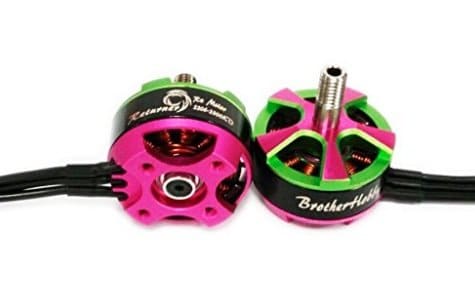
The most popular motor manufacturers include:
- T-Motor: the F-series can deliver up to 7kg thrust
- Cobra: high quality choice
- EMax: especially the RS2205 S
- Brotherhobby: esp. R4 or T2
Motor power ratings are based on Kv (thousands of RPM per volt). For a smaller 250mm spec racer, your motor’s Kv rating should be 1000-2300Kv. Use a lower Kv for larger quads.
- More than 1Kg – ~700 – 900Kv
- 500g – 1Kg – ~900 – 1300Kv
- Below 500g – ~1300 – 2300Kv
See how the most popular motors compare in real-world performance tests on MiniQuadTestBench.com.
Propellers
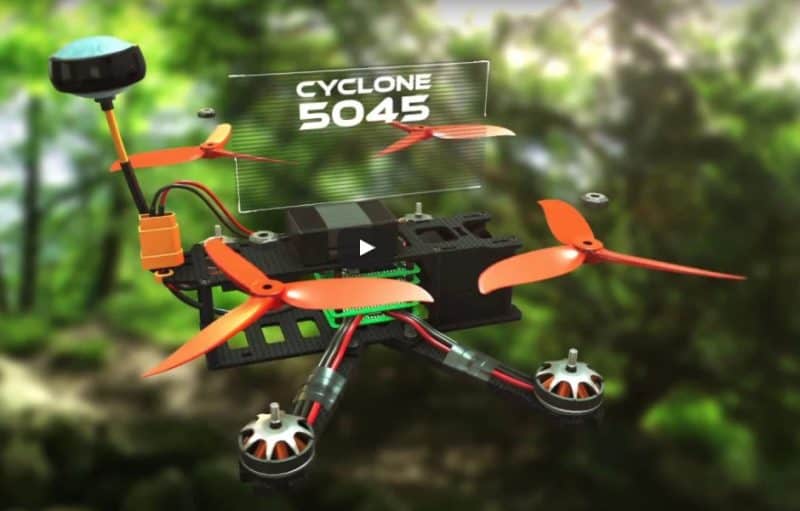
ESCs $20-40
- T-Motor F30A FPV 30A: very high quality, BLHeli_S Dshot capable
- KISS 24A Race Edition: Expensive, high quality, proven.
- DYS BLHeli_S XS30A: Dshot capable
- Spedix 30a ESC HV 3-6s DSHOT: inexpensive, light (5g), Dshot capable and smaller than most other ESCs
LiPo Batteries $25-50
- Turnigy Nano-tech
- Turnigy Graphene
- Tattu (expensive but excellent performance)
- Battery Charger: HobbyKing DC-4S
RC Transmitter/Receiver $50-100
- FlySky FS-i6 2.4GHz 10 channel: inexpensive, popular choice among racers
- Turnigy Evolution Digital: nice looking
- FrSky Taranis X9D 2.4GHz (limited supply)
HD Action Camera $50-$500
Video Transmitter $25-40
- Boscam TS351 200mW Transmitter
- Crazepony 5.8GHz 32Ch 25mW Transmitter
- ImmersionRC 25mW 5.8GHz
FPV Camera $15-40
- RunCam Swift Mini 600TVL $35-40: more latency, higher quality image
- RunCam Swift2 600TVL about $40: less latency, lower quality image
- Eachine OKKAN EK1119 1100TVL Tiny FPV Camera $15
FPV Goggles $100-$600
- Best in Class: Fatshark HD3 FPV Goggles $$$
- Best For First Timers: Eachine / Crazypony VR D2 Pro FPV Goggles 5inch 800×480 $
- On a Budget: Goolsky JJRC JJPRO F01 3D Wireless Goggles $
Flight Simulators
- HotProps: FREE. Based on Unity engine. Lots of equipment choices. Offers multiplayer option. Relatively new.
- Velocidrone: full version is $25. 17 real-life models, 14 maps, multiplayer option. The graphics are OK.
- DRL Simulator: FREE. lots of fun, but physics isn’t the best. 250mm only.
Speed & Power

FPV drone racing is more of a piloting skill test than a drag race.
Speed
Racing quads today can exceed 75 miles per hour (120kph). But top speed isn’t everything in flags-and-gates racing events – maneuverability is.
Lift Power
Lift power is always important. More powerful motors and more efficient props provide more lift, which helps you make it around sharp corners and accelerate out of a turn faster than your competitors.
Today, it’s not unheard of to have a racing drone with a 10:1 power-to-weight ratio!
For drone racers, you’ll want to use high-quality 3S and 4S motors like those made by Cobra.
For props, carbon fiber is a popular choice due to the lightweight and extra-thin, efficient design. But beware: super-strong CF props can injure, because they don’t “give” when they hit your skin.
Maneuverability
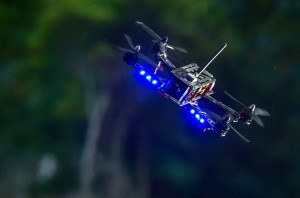
This is the most important performance characteristic of any racing drone. It’s not something you can quantify easily.
Maneuverability is the sum total of the following characteristics (components that affect it):
- control response time (function of flight controller & RC controller, mostly)
- flight stability (flight controller & flight control software)
- predictable, smooth banking (flight control software)
- lift power to stop and change direction (motors, ESCs and props)
In general, using higher-quality components will improve the characteristics above.
Durability
The smaller and lighter your aircraft is, the more durable it will be.
250mm spec and smaller Tiny Whoop class are the most resilient to crashes and accidents. They tend to sacrifice their props instead of damaging the frame.
Flight Time
Drone races rarely last more than 5 minutes. Most racers are designed for 5 minutes of hard racing, which saps batteries really fast.
Camera drones are the exact opposite – their goal is to fly “low and slow” for 15-20 mins.
Flight Controller

Flight controllers are the nervous system of your aircraft. Popular choices today include:
NOTE: some of the following links point to Amazon.com, and I may earn a commission if you buy within the next 24 hours.
- RaceFlight Revolt F4
- BetaFlight F3: includes PDB, OSD and SD reader
- Rotorgeeks SSD F3: flat underside / easy to install
RC Controller
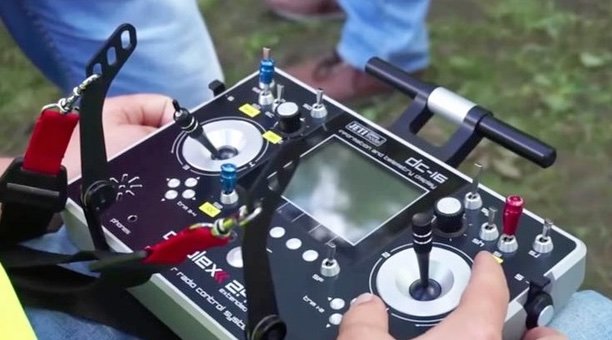
There are many RC controllers available for quads these days, costing from $100 to over $1,000.
For racing, you mainly need a reliable controller with extra-smooth, precision manual control sticks that is durable and weatherproof. Long battery life is a plus.
If you want to do special tricks, stunts or combat, make sure you have enough programmable buttons to support them.
Popular RC controllers for drone racing include:
NOTE: some of the following links point to Amazon.com, and I may earn a commission if you buy within the next 24 hours.
- FlySky FS-i6 2.4GHz 10 channel: inexpensive, popular choice among racers
- Turnigy Evolution Digital: nice looking
- FrSky Taranis X9D 2.4GHz (limited supply)
- Spectrum DX9: expensive; 9 channels; popular choice of serious racers.
- Spectrum DX6i: 6 channels; less expensive; great for beginners.
FPV Goggles & Gear

First person view (FPV) is how most people prefer to race.
The reason is simple: it puts your eyes directly on the nose of your aircraft as it flies, making the race a LOT more exciting (and challenging). FPV video can be streamed to a video display or to FPV goggles.
A complete FPV setup requires the following components:
- FPV Video transmitter (vTx) and receiver (vRx)
- Antenna
- Video monitor: your smart phone, tablet or dedicated RC controller display
- FPV goggles (optional)
- Board camera for FPV
- HD camera for recording (optional)
Popular FPV googles today include:
NOTE: some of the following links point to Amazon.com, and I may earn a commission if you buy within the next 24 hours.
- Best in Class: Fatshark HD3 FPV Goggles $ expensive
- Best HD Deal: Quanum Fatshark Genesis HD FPV $ mid-range
- Best For First Timers: Eachine / Crazypony VR D2 Pro FPV Goggles 5inch 800×480 $ less expensive
- On a Budget: Goolsky JJRC JJPRO F01 3D Wireless Goggles $ less expensive
Performance Mods

Generally speaking, a racing drone’s performance is improved by upgrading the following components (to achieve the desired effect):
- propellers (lift power)
- motors (lift power, reliability)
- ESC (maneuverability, motor response time)
- flight control software
- flight control hardware
Reducing the aircraft’s weight is another effective way to improve race performance. Pay special attention to the weight of each of the following components in your kit:
- frame
- battery
- motors
- motor mounts
- harnesses
- props
- landing gear
Other Mods
Not all drone racers are used to turn corners faster than others. Some are further modded to perform acrobatics and stunts, to shoot at targets, to take high quality video and to fight other drones – to the death.
Here are some of the more popular types of mods:
- Combat Mods
- Stunt Mods
- Target Shooting Mods
Replacement Parts
If you’re going to race, then you will be buying plenty of replacement batteries props, ESCs, frames and motors.
Because sh*t happens. Things break, when they fall out of the sky.
So make sure you consider the cost of replacement parts before you commit to a particular racing class or league.
In general, you will need to replace something just about every race. Usually props. LOTS of props.
Most drone racers bring a complete set of backup props, a couple of ESCs, one or two replacement motors and at least 2-3 pre-charged batteries to every event.
Warranty
Unlike other types of drones, warranties on racing quads are tied to the individual components and only cover defects. They don’t normally cover damage caused by competing.
If something breaks during competition due to crashing, etc. then you’re out of luck.
This applies to both RTF rigs and ATF drone kits.
Resources
There are dozens of enthusiast blogs and forums on the Internet where dedicated drone racers hang out and discuss the finer points of modding, race rules and the latest gear.
Here are a few of my favorites:
FPV Racing Blogs
- MiniQuadClub
- DroneBlog
- DIYDrones – list of blogs
- RacingFPV
Drone Forums
Where To Buy Parts
- Amazon.com: always worth checking for price; free shipping, too.
- HobbyTron.com
- HobbyKing.com
- Helipal.com: experts at RC quad racing, awesome customer service.
Learn How To Fly a Racing Drone
- Drone Racing Guide – Beginner Level: The Complete Guide to Drone Racing ($2.99 ebook): A Great, easy-to-read introduction to the art of FPV racing. A step-by-step process to move from awareness of basic flight controls to advanced acrobatics.



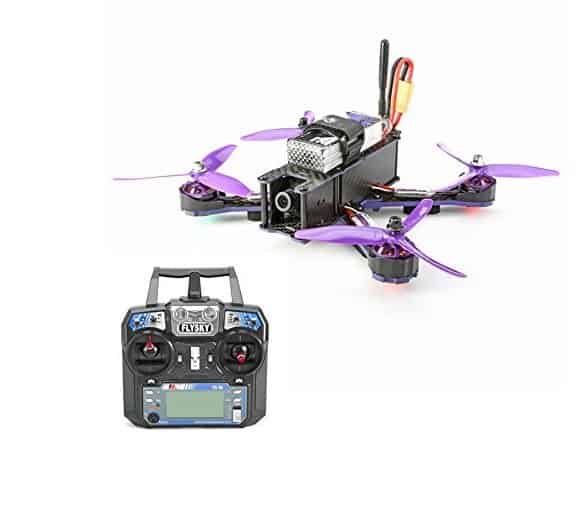


Can’t read the guide because the contents window is stuck in the middle of the screen at all times
Sorry about that. It’s a bug w/ a plugin we use. Try going back to top of page, then touch “Hide”.
Thanks, and great guide by the way.
GREAT guide, Andrew. You just saved me a helluva lotta time! Thank you man!
Agreed… great info for the beginner! Thank you! I had an old drone kicking around all busted up didn’t know if any of it was salvageable…. now I am stoked to tear it up and start building a racer. Guys like you who post stuff like this, makes entering a new foreign field of tech for this old guy, fun and time saving.
Tell me where i can buy professional tracks for racing? Thank you
your table of content list just popped up and blocked everything, cant read the article
First of all, these are “Multicopters” not “drones”.
A multicopter is a “type” of drone. Just as a dog is a “type” of animal. You don’t refer to your dog as an “animal” because it doesn’t give him credit for his unique dog abilities or intelligence. It’s the same with multicopters. “Drone” is patently incorrect. It’s like saying “I’m going to take my transportation to work”. What type of transportation? Car? Bicycle? Using “drone” in this context is bad if not incorrect English.
That would actually be the best lesson you could give beginners; the proper terminology and vocabulary for their new-found hobby.
Good point – you are technically correct. But few people say ‘multicopter’ unless they have a professional aviation background or a long-time RC background.
I have to agree with the whole drone thing. I don’t of think of my quad as a drone. Its a multi rotor and that’s what spills out my mouth when I talk to people about it. I never say drone and honestly it doesn’t enter my head.
One other thing. Sunny sky motors you got listed as a cheap alternative to cobras. Cheap hun? I guess that’s why they are counterfeited more than any other motor right? Because they are cheap and not worth your time. Yeah , no you should probably look for another way a saying whatever it is you we’re implying about some of the best best most affordable motors made if you can source the authentic thing – try Buddy RC, RMRC or GetFPV and other more worthy American based vendors and stay off Ebay and Amazon. Those later two markets being some of the worse places to source anything legitimate in RC parts. Remember its isn’t saving you money if you have to buy it twice after it causes you to wreck your entire multi-rotor investment.
The only thing a beginner should consider investing in substantially when starting out is a good radio and the accompanying receiver technology, ( Futaba (expensive), Aurora(mid range pleasure to set up), Graunapur(mid range), Spectrum(expensive but easy to setup), and of of course the open source wonder The Taranis, (Best value bar none yet most difficult to learn bar none); Also note the new TBS and Turnigy evolution type radios comming to market now – they are more simple, more spartan and limited radio yet are all one needs for a racer/acro/FPV multirotor focus).
If I were starting out today I would look at the Turnigy Evolution or a Spectrum DX6 and then later when I was ready or if I needed to I would step into that wilderness and often living hell that is the FrSky Taranis. Personally, I have a Taranis and yes I can get it to do almost anything if I spend the time figuring it out. But honestly I kinda loath the radio, hate it actually, and look at it with a certain urge to punch it off my desk for being such a bitch to work with and that annoying bratty voice saying “Wecome to OPEN TX” every time i turn it on. No, the voice is only cute at first after that you only want to hear from it when it tells you your battery is low or your lossing signal, (ie weak RSSI). Just remember the radio you invest in will be the only part of the equation that is not going to crash. It will be the only thing you’re left holding when that quad decides to fly the wrong way as all multi-rotors do sooner or later.
The irony of the multi-rotor is that nearly every one made will ultimately end its life in a crash – if it doesn’t then why was built in the first place if not to be used until the odds and/or the 2nd law of Thermal Dynamics brought it down? Only bad quads live forever in boxes and on shelves. The good ones all die in a blaze of glory – so don’t put too much heart into that multi-rotor project you’re building just so. If you build it well then you should know that by making it the perfect craft you also seal its demise. That sweet machine will one day return to being random pieces scattered on the ground. Every single one worth building cannot escape this fate. Its a part of every multi-rotor’s life cycle. Kinda like everything else I suppose.
The money one spends in this hobby is almost certain to be lost completely. Even like new RC stuff in a year will be old technology and hardly worth the effort to resell. If you can remember that the money you spend is gone forever the moment you commit to buying that next RC component you won’t be disappointed. The investment you make is for the experience and memories a flying hobby offers. And isn’t that what we should value the most? After all its only our memories that we are left alone with when we finally pass to the other side. Flying multi rotors or any kind of Drone, (please note this proper use of the word drone in the proper context), for that matter is the closest one can get to flying without actually owning a plane. Its really the only reason this hobby exists for me into adulthood. As much as I like making models – if I thought my quads would never fly I would have lost interest back when I gave up building plastic airplane models as a kid.
Bill,
Thanks for sharing your experience. All great points. Most people who read this guide are new to the sport, so this kind of experienced input is really valuable.
I agree w/ you about investing in a good radio + receiver first, vs. your first rig.
Also, you make great points about the real nature of this hobby, i.e., that you are spending money for experiences, fun and thrills – not investing in a machine. You WILL crash a lot, especially when learning for the first time – and still, all the time, afterwards.
Re. Sunny Sky motors, yeah I agree, I could have said that better. Edited it.
Who cares? Seriously. This comment misses the point of this article entirely. This is about helping beginners get into an incredibly fun hobby. People who don’t even own a drone or quadcopter or multi rotor do not need a lecture on proper terminology. They need advice on which drone is right for them. Which is what the article is about! But congratulations on being so amazingly well versed in drone terminology. I’d say you are an asshole but that is just a general term for a person who is condescending and argumentative simply to do so. But what kind of asshole are you? You are a large diameter, puss weeping asshole.
Have a nice day Grant. Be sure to kiss your mom with that mouth of yours. Would you talk to her that way?
Why would I talk to my mom that way? She’s not a condescending asshole who enjoys playing semantics to make themself feel superior.
How did you completely skip over the vortex 250pro for an rtf package? It’s extremely competitive, very upgradable, easy to learn on, but capable of winning. You also mention the d4r but not the more common x4r. And you mention the qav g10 as the top pick, which no seasoned racer would ever reccomend g10 as anything other than a budget option. I have been in the rc world for over 15 years, rc aircraft and multirotirs over 10, and have been avid in mini quad racing and fpv for over 3. I fear a great deal of this info will lead new comers astray or down a disappointing path. For many a bad first quad is a dead end into the hobby. I reccomend all people that ask me to first get the basic hubsan, then dive in with an fpv setup, but the best quality they can afford for radio, goggles, and quad. Waiting for the right setup is often better than spending money to be disappointed, being forced to either buy twice, or simply give up. People getting into the hobby need to also understand that buying rtf doesn’t guarantee a great experience. You will crash and will need repairs. The cost of those repairs, and ease of repair will drastically effect your experience. This again is why I believe the vortex is the best rtf quad you can buy. Damn near bulletproof, and if something breaks repairs are very easy.
Steven,
Thanks for sharing your experience.
As you know, there are a million opinions in the experienced FPV world about which setup is best, for whom, depending on budget.
I agree with you (completely) that there are other, more expensive setups that experienced drone racers will choose over the QAV250-G10. But by the time you get to that level of experience, a page like this one isn’t as helpful.
This guide is written for people entering the sport. I’m trying to give them a path to success, which starts w/ the Hubsan (which you agree with, too). I still believe the QAV250 G10 is a fine multi-rotor to use for your second setup. So does Charpu, fwiw.
Also, thank you for recommending the Vortex 250pro, which was released early this year – right after I wrote this guide. Looks like a great alternative to the G10 – i.e., not for beginners.
As far as the QAV250-G10: I’m hearing the new QAV-R is a great upgrade – lighter, easier to swap-out parts, etc. What have you heard about it?
Thanks again for chiming-in.
I just added my review of the Vortex 250 PRO.
I agree with you: it’s a better upgrade than the Lumenier QAV.
How much customization is legal? I come from an engineering background and I’d like to automate a few things like height control (to make better use of ground effect), optimize turning and stuff like that. Is that competition legal? Also are there limitations on the motors, as in: Can I legally use my custom made ones? Is there a minimum size? I’m sure I can look up all this stuff somewhere, but I have no idea about this sport and just got pointed towards it.
Great guide, by the way, thanks a lot.
Sorry for the late reply. The amount of customization allowed varies by type of race and by league. Ask your league what their rules are.
Here are the racing leagues I know about, so far:
Aerial Grand Prix: A gates-and-flags racing league for 250Mini, Pro Super Mini and Open Class drones. Events in major cities world wide. Indoor and outdoor tracks.
Aerial Action Sports League: a 3-hour stunt drone and combat drone event, managed by Game of Drones.
Game of Drones: a global racing league that uses Hiro drone kit sold on their website.
Flight Club: local aerial combat events, organized by Game of Drones.
FPVRacing.TV: a social network of racers organized into teams. Open-spec. Lists global events.
NorCalFPV
MultiGP: for first-person view (FPV) radio-controlled quadcopters only. Started in 2015, currently adding US city chapters.
OpenPilot: a popular open-source autopilot system used by drone racers
RacingFPV.com: Canadian indoor racing league; 250mm and open class. Flags and gates.
SoCalRotorRacing
TeamRaceKraft
The Mini Quad Club: popular Facebook group where meetups and mods are actively discussed
Hi Andrew i’m new to the multicopter scene having a bit of a play on my mates phantom. It was pretty cool but i’m leaning more towards the smaller & faster racing drone scene. What are your thoughts on the Storm racing drones?
Storm is a great & proven platform, but things change fast in racing drone land.
Right now, I’d say the Vortex 250 is probably the best racing drone (value for money) for someone like you, who knows how to fly a drone and wants to compete. It’s got a much stronger CF body than the Storm, and it’s easier to swap parts and program/tweak in the field..
Check out my review (http://bestdroneforthejob.com/drone-reviews/vortex-250-pro/) to learn more.
Thanks a lot Andrew 🙂
If you wouldn’t mind could you give me your thoughts on this package i’m seriously thinking of purchasing as it has everything included for my first venture into racing drones until i’m experienced enough to eventually build my own. It’s $849 U.S & around $1100 AUS for me.
*Runner 250R GPS Specifications* :
Main Rotor Dia : 143mm
All-up-weight : 446g (w/o battery)
Dimension : 236mm x 205mm x 102mm
Remote Controller : Walkera DEVO 7
Receiver : DEVO-RX710 (R)
Main Controller : FCS-RUNNER 250 (R)
FPV Transmitter : TX5816 (FCC)
Brushless Motor : WK-WS-28-014(CW/CCW)
Brushless ESC : RUNNER 250
OSD : Runner 250 OSD (R)
Battery : 11.1V 2200mAh 25C 3S LiPo
Flight Time : 11~12mins
Working temperature : -10℃~ +40℃
Camera : 1920 X 1080p 60fps, Max 64GB SD Card, .mov format,
DEVO 7 Specifications :
Encoder: ARM micro computer system
Frequency: 2.4Ghz(DSSS)
Output power:-5dBm~20dBm
Battery: 1.2VX8 NiCard or1.5VX8 AA dry batteries
Current Drain: ≤170mA
*This is the Deluxe Edition which includes* :
1. Fully Assembled Walkera Runner 250R GPS w/ 1080p HD Recording Camera
2. Walkera DEVO 7 Radio System
3. 11.1V 2200mah 25C Li-Po Battery
4. Walkera FPV Goggle 2 w/ Battery
5. 2pcs Clockwise Propeller
6. 2pcs Counter-Clockwise Blade Propeller
7. Battery Charger
8. English Manual
9. Protective Backpack w/ soft foam line
It looks great!
Let us know how it performs…
I have a website where I sell drone parts for beginner pilots looking to build their first drone, weekly freebies come check us out!
gogocopter.com
Andrew I am just a guy with a bit of experience do you think a GB190 would do?
Andre,
I think the GB190 kit is an awesome value for a beginner-to-intermediate flier, for the following reasons:
– it’s fairly easy to assemble
– frame is tough
– it’s very fast and performs well
– I love the look, with those triprops
But I haven’t flown one, so keep that in mind.
Make sure you have soldering skills. Couple of tricky steps involved.
Here’s a step-by-step assembly on FPV.tv: http://fpv.tv/most-powerful-fpv-racing-drone-gb190-angry-hornet-build-part-1/
Have fun!
I have flown rc helicopters a lot and an pretty good i want to get a race drone what should i start with i was thinking the storm type as3?
The Vortex 250 has a really durable frame/chassis… so if you’re comfortable assembling RC aircraft then I’d buy that one. It’s immediately competitive, after you master the controls.
Is there any better not as expensive models. i dont have a transmitter or screen/goggles.
My two boys, both age 10, and I have been watching drone racing on TV and one of my boys is fascinated. He really wants to get one and start racing. Now the hard part. No clubs within 3 hrs drive. I have no idea what to get him to get him started and he’s never flown a drone. I haven’t flown RC since my brief helicopter time back in 1989. I stopped that when I went into the Navy and haven’t flown since. Should I get him a racing drone to start? I’m in the $600 market and would really like to give him one for Christmas. I may end up getting his brother and myself one later if he takes to it. Any and all help is greatly appreciated.
Allie,
For a 10 year old boy, I would strongly recommend starting him on a training drone like the Hubsan X4 107D (about $85), which he can safely fly inside.
Here’s my review of the X4: http://bestdroneforthejob.com/drone-reviews/hubsan-x4-h107d-fpv-quadcopter/
Understanding this may be a let down, you may want to include a ‘gift card’ with the Hubsan saying something like, “when you master this training drone and learn how to fly safely, this card entitles you to a free upgrade to a Vortex 250 Pro”.
Total cost for both is about $600. Vortex ranges from $499 to $569.
And, yes, I’d recommend the Vortex 250 Pro as the upgrade… assuming he is still interested in the sport after learning how to fly the Hubsan.
NOTE: all racing drones have a learning curve. They are not for most 10 year olds, although I would never say never. It really depends on the person. Make sure you read my review first: http://bestdroneforthejob.com/drone-reviews/vortex-250-pro/
I will be publishing a long list of online courses, soon, which you can use to educate your son on UAV flight safety and operating principles.
Bottom-line, this is an excellent opportunity to train your son to patiently learn how to pilot an aircraft correctly and to learn the protocols required to safely pilot a UAV near other people.
Then, he will have a LOT more fun racing, garner more respect from his competitors – and crash less ($$)!
Have a wonderful Holiday Season.
I ordered three X4s, one for each of us, plus 10 extra 500mah batteries and some spare blades. Now I just have to find a good charger. Their hand eye is unbelievable. They go from game system to game system flawlessly. They could spend all day on FPS games and be happy. Their birthday is in March so they will have a goal to reach. Thank you for your fast response and the well thought out advice.
My two boys, both age 10, and I have been watching drone racing on TV and one of my boy’s is fascinated. He really wants to get one and start racing. Now the hard part. No clubs within 3 hrs drive. I have no idea what to get him to get him started and he’s never flown a drone. I haven’t flown RC since my brief helicopter time back in 1989. I stopped that when I went into the Navy and haven’t flown since. Should I get him a racing drone to start? I’m in the $600 market and would really like to give him one for Christmas. I may end up getting his brother and myself one later if he takes to it. Any and all help is greatly appreciated.
Andrew,
thanks for the guide.
Being a beginner I am considering buying a Hubsan X4 H107D. However – I don’t know why – the Hubsan X4 H107D+ is currently cheaper than the normal H107D. As far as I understand the H107D+ has better camera. Is there any reason I would not choose the H107D+ over the normal H107D?
Thanks
Edmund
http://www.ebay.com/usr/sqsstore
Hey there. Love this article!
I feel Tiny Whoop style quads are worth mentioning though. It can be for beginners up to pros.
There are also 2 big facebook groups you may want to look into as well! Drone Racing – Beginners Group and Tiny Whoop – FPV Pilots of the World. These people are honestly some of the most helpful you’ll ever see because everyone wants to have fun and grow the community.
Thanks for the tips!
Yes, the Tiny Whoops are really taking off – I haven’t had a chance to play with one, yet. Hope to do that soon.
Hey Andrew,
that’s one heck of a comprehensive article, for us who are not familiar with racing drones, this is incredible informative, so thanks for that.
Can I ask you a quick question?
I’d like to start getting myself in drone racing. Now, I do believe that custom built drones are going to get better results of course, but am I taking too much of a risk by going for a custom build rather than a ready made drone?
David | Founder | https://www.dronesbuy.net
hey everybody, my question is tthat is dji mavik pro is good for racing without crashing
No, I wouldn’t use the Mavic Pro for racing. It’s not really designed for that.
Hii can i ask you , i want to build my first drone with :
QAV-X 130mm carbon frame
dys f4 fc with pdb and osd
dys f20a 4in1 esc
dys bx1306 4000kv
dys 3045 propeller
Battery 3s
How do you think about that? Are there any constraints or problems? Can you give me feedback , thanks :))
Hey, I’ve been looking into drones a lot and am very interested. I have a drone myself that can go sort of fast but im looking into a better upgrade. Also after playing the Drone Simulation by DRL I’ve found that the controls are different. Right now I’m looking into getting the Eachine Wizard X220 from Amazon at $280, it would be worth it to get this? I’m experienced with drones but not as experienced with racing drones? I’m also looking at FPV goggles and I’m just making sure that I should not get these until I’m ready to fly the drone by itself, right? I’m sorry for all the questions I’m just so excited about this!
Sincerely, Tyler
The Wizard X220 is a great choice for a starter drone!
Lots of mods available, so you can continue to improve/enhance your rig.
Before you buy, check out the awesome and very active support group on Facebook: https://www.facebook.com/groups/339401686446977/
Have fun!
I love drone racing and even i want to take part in race, but sadly I am not still prepared for this. Anyways, I love all the above drones specially the yellow one. Great post and very well written.
Does anyone buy parts from http://www.droneracingparts.com
https://www.kickstarter.com/projects/1055208503/bbt-race-gates-the-ultimate-micro-drone-racing-exp?ref=2vbwbb
I read about it. It sounds great too. I took part in drone racing from last 1 year. It’s awesome game. Everyone enjoy this game. There are so many companies who arrange drone racing game. Now a days, drone racing trend is growing and so many competition arranged every year.